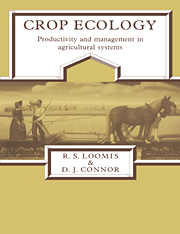Book contents
- Frontmatter
- Contents
- Preface
- Part I Farming systems and their biological components
- Part II Physical and chemical environments
- Part III Production processes
- Part IV Resource management
- 12 Soil management and sustainability
- 13 Strategies and tactics for rainfed agriculture
- 14 Water management in irrigated agriculture
- 15 Energy and labor
- 16 Analysis of wheat–sheep farming in southern Australia
- 17 Mixed farming in the North American Corn Belt
- 18 Towards an uncertain future
- References
- Species list
- Conversions and constants useful in crop ecology
- Index
12 - Soil management and sustainability
from Part IV - Resource management
Published online by Cambridge University Press: 05 June 2012
- Frontmatter
- Contents
- Preface
- Part I Farming systems and their biological components
- Part II Physical and chemical environments
- Part III Production processes
- Part IV Resource management
- 12 Soil management and sustainability
- 13 Strategies and tactics for rainfed agriculture
- 14 Water management in irrigated agriculture
- 15 Energy and labor
- 16 Analysis of wheat–sheep farming in southern Australia
- 17 Mixed farming in the North American Corn Belt
- 18 Towards an uncertain future
- References
- Species list
- Conversions and constants useful in crop ecology
- Index
Summary
INTRODUCTION
Proper management of soil resources is the key to sustaining agriculture because soil properties constrain, sometimes to a major degree, the type of farming that may be practiced and because soils are altered by farming practices in ways beneficial or deleterious to their long-term value for agriculture. The complex and variable nature of soil processes make accurate predictions about below-ground conditions difficult, however, and farming usually must proceed with only general knowledge of fertility levels, drainage, water-holding capacity, and tillage responses.
Soil characteristics important for sustainability include the ability to supply essential plant nutrients and water and the ease of tillage. Fertility management employs crop rotation, return of residues and animal wastes, and application of fertilizers to maintain adequate supplies of essential nutrients in the face of losses by removal in crops, by leaching below the root zone, and by erosion. Maintenance and improvement of profile depth suitable for rooting requires control of erosion and proper drainage and tillage. Tillage is the primary tool for soil management and has important effects on fertility, erosion, and weed control. Ease of tillage depends upon several factors including water content and the distribution and types of clays and organic matter in the profile.
Spatial variability
Soil management practices aim at creating reasonably uniform, favorable, conditions for plant growth in all parts of a field. Spatial variability of landscapes limits attainments of those goals. Profiles are seldom uniform across a field.
- Type
- Chapter
- Information
- Crop EcologyProductivity and Management in Agricultural Systems, pp. 319 - 348Publisher: Cambridge University PressPrint publication year: 1992
- 1
- Cited by



